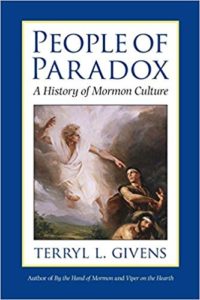 Author: Terryl L. Givens
Author: Terryl L. Givens
Title: People of Paradox: A History of Mormon Culture
Oxford University Press, 2007, 414 pages.
Reviewed by Conor Hilton, Dec. 9, 2018. 4 stars.
I adored this book. A fascinating and thought-provoking collection of thoughts on the different ways that what Givens’ terms to be Mormonism’s central paradoxes manifest in a variety of different cultural expressions. Part I explores these four paradoxes in depth and is likely the most robust and, for me, provocative and foundational section. Givens’ work in this opening section bears relevance to loads of other strands of Mormonism. Parts II & III look at case studies of these paradoxes playing out in different cultural realms (life of the mind, architecture, music & dance, theater & film, literature, and visual arts). Part II is from the Church’s founding to 1890 and Part III covers 1890 to the present. These sections are filled with interesting tidbits and anecdotes and occasionally peppered with academic praise (notably for Richard Dutcher) along with some glorious academic shade (the architecture chapter in Part III most notably). There’s definitely room for critique of the selection that Givens draws from to craft his arguments in these chapters and where he places most attention. Part III also has a largely American Mormon focus (which is understandable, but I wonder what the paradoxes manifest as outside of a US-Mormon context, though loads of contextualization would likely need to take place for that conversation to bear fruit and not divorce such works from their important contexts). I wonder what an addendum to Givens’s book that takes into account some of the ideas from the recent Decolonizing Mormonism collection edited by Gina Colvin and Joanna Brooks and looks at artists that have been on the rise since 2007. Lots to love here and I’d love to see others continue and complicate Givens’ project here.
